
Review: Chamonix 45F-1 4×5 camera by David Tatnall
Chamonix cameras have been made in Haining in Zhejiang Province China since 2005 by a small company of eight craftsmen. They make eighteen camera models from 4×5 up to 20×24 from wood, carbon fibre and anodized aluminium.
This is a review of the 45F-1 folding field camera model.
Context
This is my third 4×5 field camera. My first, a lightweight (one kilogram) wooden field camera purchased in the1970’s lasted nineteen years. It was replaced with a metal field camera that despite new bellows and two major repairs due to being blown over was going well until an encounter with a wave finally seized up the movements. It lasted twenty-two years. If this camera lasts as long, I’ll be well into my eighties went it needs to be replaced.
 45F-1 showing Frensel screen, focusing knob, rear tilt & asymmetrical tilt knob & three of its five spirit levels.
45F-1 showing Frensel screen, focusing knob, rear tilt & asymmetrical tilt knob & three of its five spirit levels.
The camera
Straight out of the box, my first impressions were its beautiful finish, and its light weight (weighing only 1550 grams).
Once the camera is on a tripod, the rear standard simply lifts up and is locked in place with two knobs on either side. There are two small lugs that hold the rear standard at 90°. These disengage to allow the standard to move forward or backwards.
The front standard is not attached to the base plate, there are five screw holes along the base plate and the front standard screws into one of them (depending on the lens you choose). Very simple and straightforward.
Lens boards are ‘Linhof’ type 96 x 99 mm. These attach with two semi circle locking devices.
The camera comes with a universal bellows, that can be used for very wide angle and long lenses. Bellows maximum extension is 395 mm and minimum is 52 mm. (Lenses I use are 75mm, 90mm, 150mm and 210mm). The bellows can be easily removed for the installation of bag bellows.
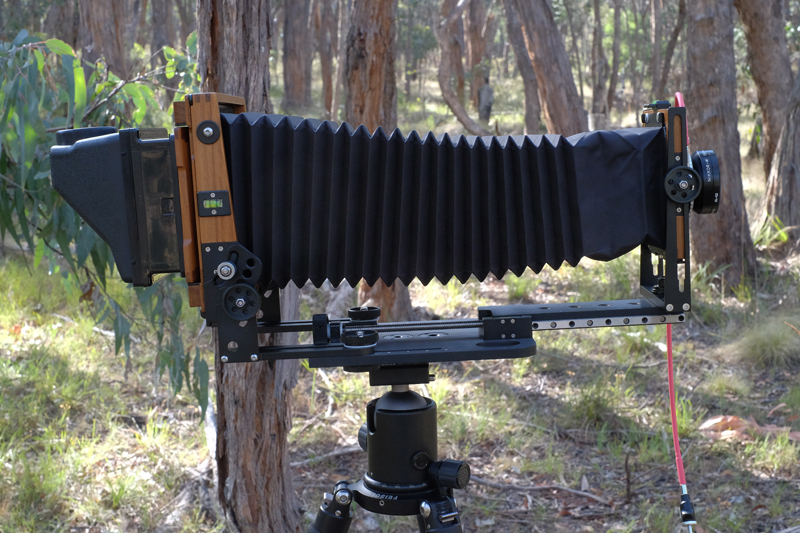 45F-1 showing bellows extended to 395mm. With 45 degree reflex viewer attached.
45F-1 showing bellows extended to 395mm. With 45 degree reflex viewer attached.
My previous cameras didn’t have spirit levels built in, but the 45F-1 has no less than five spirit levels attached to the camera.
The camera is capable of a great degree of movement; front rise 45mm, fall 30mm and shift 20mm; tilt and swing is only limited by the bellows; rear tilt 20 degrees backward, forward is limited by the bellows; rear swing is 20 degrees with no shift. Asymmetrical tilts of the rear standard are possible with this camera, making the use of the Scheimpflug Principle in composition practical.
 45F-1 showing some of its movements. With 45 degree reflex viewer attached.
45F-1 showing some of its movements. With 45 degree reflex viewer attached.
The camera comes with a carbon fibre ground glass protector and a material camera wrap. I ordered an additional Fresnel screen with my camera. There are a number of other accessories available, including wide angle and standard bellows, extension boards for macro photography (this extends the bellows to 450mm), a folding viewer, a 45° reflex viewer and a folding viewer with carbon fibre cover. There is also a leather ‘jacket’ protector. Roll film and other holders can be attached via a Graflok mechanism.
Using the camera
I’ve now used the camera enough in different conditions – ranging from minus 10°c in the Alpine National Park in winter to 38°c in mid summer in woodlands near Melbourne – to be comfortable in writing this review.
Setting up the camera (as described above) is simple, quick and straightforward – even with gloves on in minus 10°c.
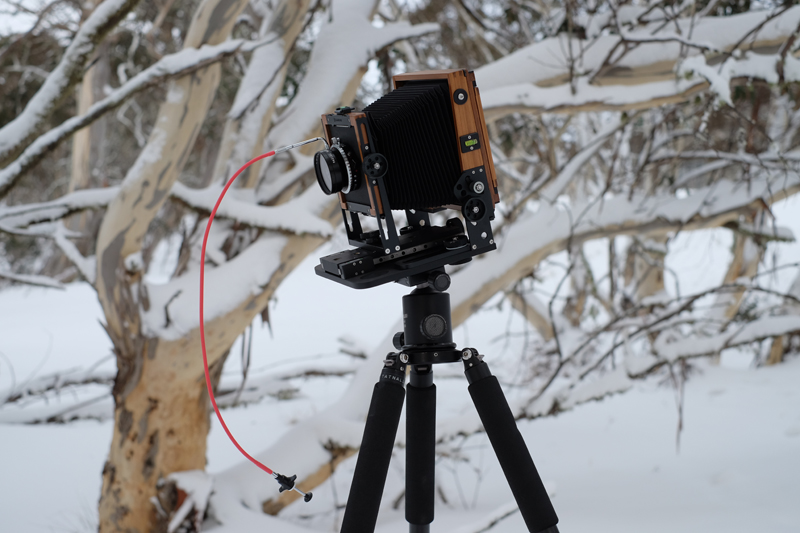 45F-1 with 150mm lens. The Razorback, Alpine National Park, Australia.
45F-1 with 150mm lens. The Razorback, Alpine National Park, Australia.
Possibly the biggest difference between this camera and other field cameras is the focusing. On almost all other field cameras focusing is achieved with knobs on both sides at the front of the camera bed. On Chamonix cameras it is centrally located under the ground glass at the rear of the camera. This is a far more logical place to focus the camera as usually one hand is holding a loupe on the ground glass. Having the focusing knob directly under the ground glass is far more ergonomic. It took me very little time to get used to this considering I’ve been focusing view cameras with front focusing knobs for more than forty years.
All the control knobs are easy to use, the focusing knob doesn’t have a lock, but due to its clever design doesn’t slip or move until the knob is turned.
Small white dots on the front standard, base plate and rear enable the camera to be returned to neutral position with ease.
Using the camera; from getting it out of the pack, setting it on the tripod opening it and putting on a lens takes very little time. Focusing is very straightforward and making camera movement adjustments is very easy and ergonomic. Orientation from horizontal to vertical is done by lifting two levers removing the back and replacing it and locking levers.
Folding the camera up after use does require a little practice as knobs on the base plate need to be in a position to clear the folding front standard. But after a couple of goes at it, this becomes second nature.
Conclusions
In teaching large format photography workshops I have been fortunate to see a good number of different cameras used by workshop participants. Chamonix cameras stand out as cleverly designed, well-made and practical.
When I retired my metal 4×5 camera my replacement choice was simple, having handled several Chamonix cameras it seemed an obvious decision. It is an excellent lightweight view camera that is ideal for backpacking. It is robust and sturdy making it an ideal camera for landscape. Its versatility with movements also make it a very good camera for architectural and general photography use.
The ease in which bellows can be changed and attachments added such as the 45° reflex viewer, make it a very attractive and practical camera.
Photographs I have made with this camera so far have been very pleasing, and I look forward to using it for many years to come.
 45F-1 with 75mm wide angle lens. Little Desert National Park, Australia.
45F-1 with 75mm wide angle lens. Little Desert National Park, Australia.
Chamonix cameras http://www.chamonixviewcamera.com
David Tatnall https://en.wikipedia.org/wiki/David_Tatnall
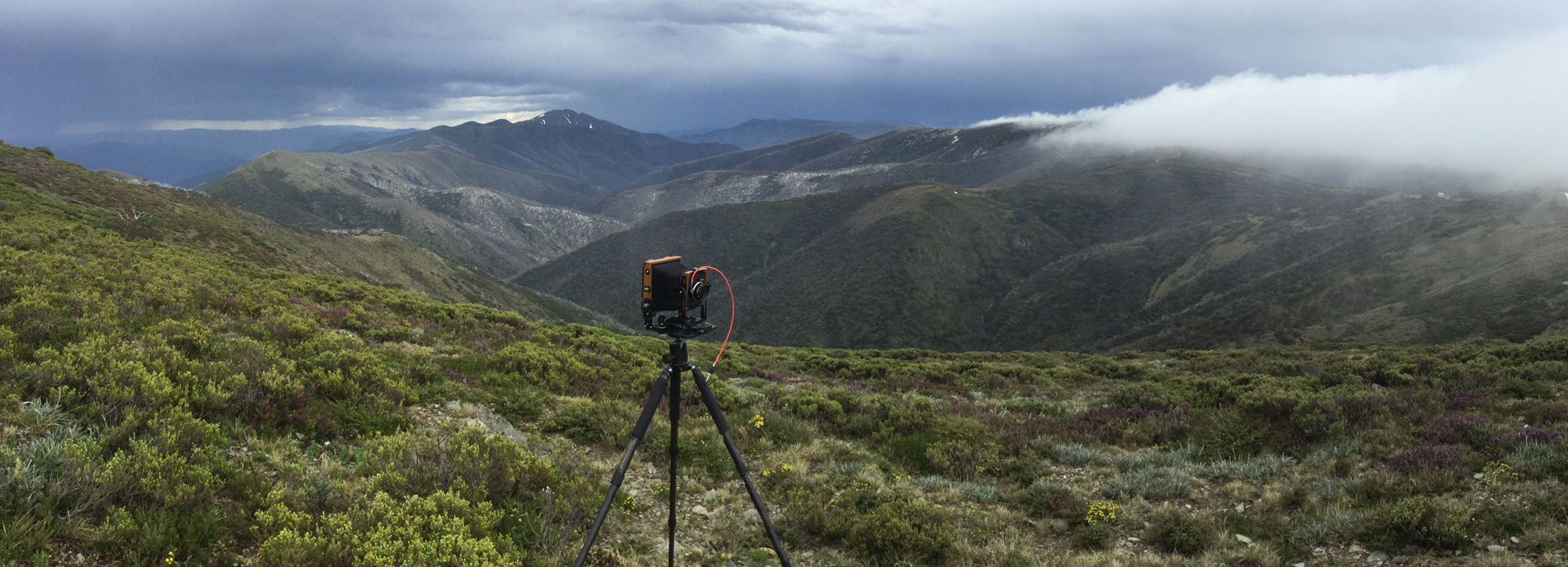 45F-1 The Razorback & Mount Feathertop. Alpine National Park, Australia.
45F-1 The Razorback & Mount Feathertop. Alpine National Park, Australia.
The photographs below have been made on the 45F-1 in the past ten months. All silver gelatin prints 24 x 30 cm.
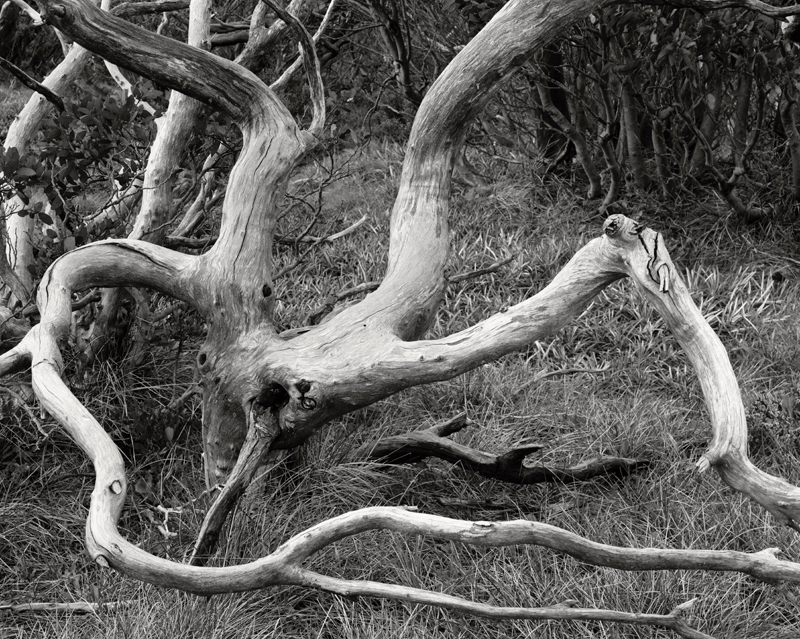 Burnt snow gum. The Razorback 2017. Alpine National Park.
Burnt snow gum. The Razorback 2017. Alpine National Park.
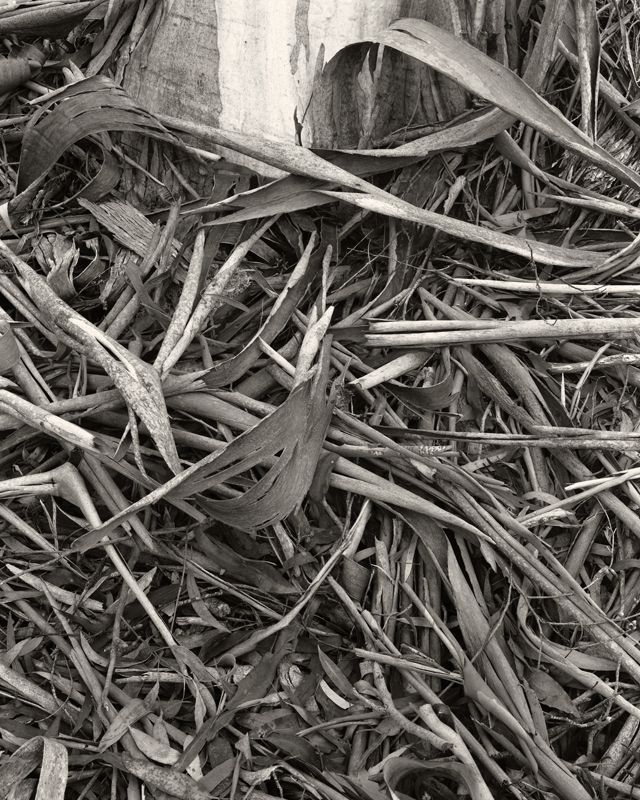 Snow gum bark 2017. Mount Buffalo National Park.
Snow gum bark 2017. Mount Buffalo National Park.
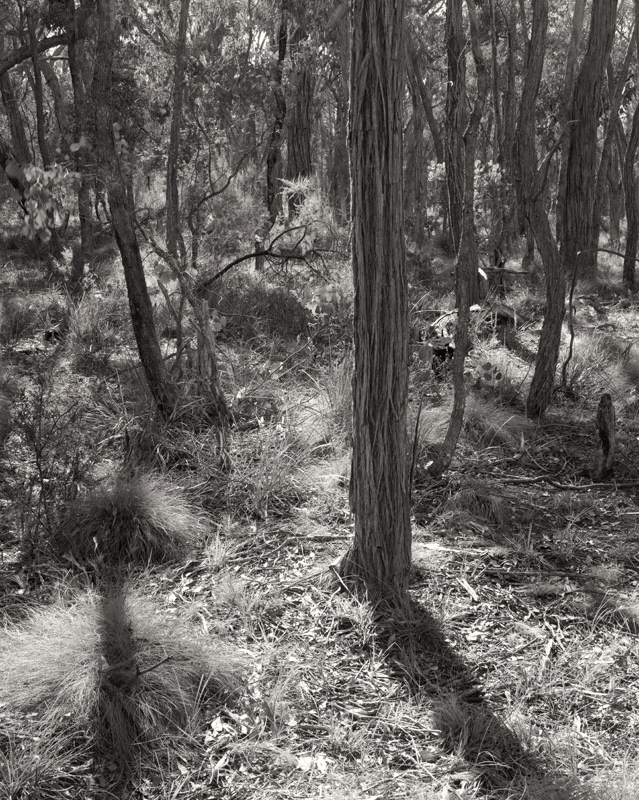 Woodland 2018. Castlemaine Diggings National Heritage Park.
Woodland 2018. Castlemaine Diggings National Heritage Park.



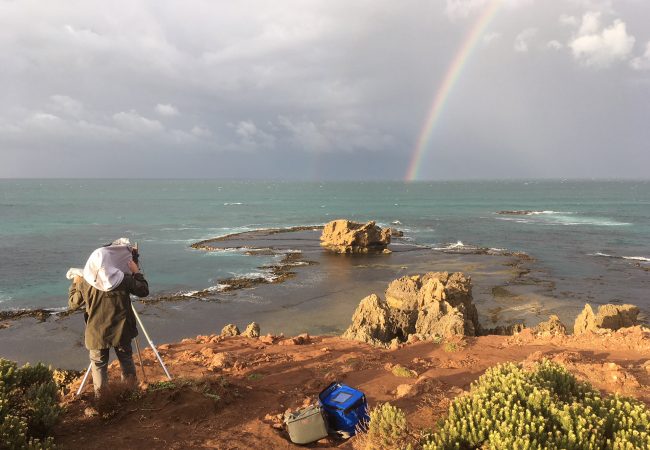
Dear VCA,
I was very very pleased AND surprised to find your site. Large format “analog” photography is apparently still alive !
And not only that, but new camera’s are still being developed and build. I’m amazed.
I just read the review by David Tatnall about the 4×5 Chamonix camera. Fan-tas-tic ! There’s still hope !
For various reasons I had to sell my old Graflex 4×5 a few years ago and I really thought the analog photographic age had ended.
I now live in Holland, but for 18 years I lived in Australia of which the last 3 years were in Tyagarah NSW (near Byron Bay)
Had built my own darkroom and even modified the Graflex camera so I could also use it as a enlarger. (no money you see)
Again, it’s very pleasing to know that large format is still alive and kicking.
Thank you !
regards, Rob Sandifort (70)
Rob, thank you. Yes large format photography is alive and kicking in Australia. It’s getting more popular with is very good news.
Hello! Really nice article. Is there any room for rise/fall with the wide angle lenses, or is the bellow too much “tight”?
If there is room, how much (give or take?).
Thanks!
Marco, the universal bellows that are standard with the camera allow for movement with wide angle lenses. I use a 75 mm lens and have never been restricted by the bellows. Chamonix do sell a wide angle set of bellows for the 4×5 camera , that may be useful if you wanted to use extremely wide angle lenses.
Awesome and thanks for the reply. My widest lens (for now!) is an 80 mm, so It appears that I should be good even without a recessed board!
Marco, all the best with your photography!
Hi David,
thank you for the review.
I see you are using the reflex viewer.
How are you finding it??
Do you remove it for focusing or do you find the 3x magnification adequate??
Best Regards
Michael
Western Australia
Michael, I’ve use the reflex viewer for some years now. I think it’s excellent. It makes using the camera in windy conditions much easier and generally makes using the camera faster. I find the amount of magnification adequate, in fact I haven’t used a loupe for fine focusing since using the reflex viewer. The only down side is its bulk when carrying. I have a fresnel screen on my camera and using a 75mm lens makes viewing the corners on the ground glass a bit of a problem with the viewer, this is only an issue if you have a fresnel screen.
Thank you David for your response.
That is great to know.
I was worried that 3x magnification might make it a struggle for focus.
Though realistically it is not far removed from the 3.5-4 x reading glasses I use to focus.
Best Regards
Michael
Hi David
Thanks for the great review on the Chamonix.
I am new to large format and keen to put the camera to use.
Can you please advise where you got your reflex viewer? I have the 5×7 Chamonix and Im trying to make it as practical as I can.
Regards
Gary
Gary thank you. The reflex viewer I have is from Chamonix. I don’t think they make one for the 5×7. The reflex viewer certainly makes using the camera more practical. You may have to look for one made by a third party for your 5×7 camera.
David, I have a Sinar P2 with binocular reflex magnifier plus the hood for it. It’s very convenient and removes the need for a dark cloth and loupe. I’ve now got a Chamonix 045 N-2 field camera and can see the reflex viewer you have for it will do a similar job as the Sinar equivalent although one eye only. According to the Chamonix website they’ve sold out of these. Perhaps they’ll make more. I don’t know the Chamonix cost but one I saw on eBay was over $300. I’ve also read about the Polaroid binocular viewfinder (somewhat cheaper but heavier) that would be equivalent to the Sinar type, and some Chamonix users have adapted the Polaroid one. Using a cloth in windy conditions certainly tests one’s patience.
Ray thanks. I’ve used my reflex viewer for some years now, it’s extremely good. Light weight and eliminates the need for a loupe. However can be problematic with wide lens if you have Fresnel screen, but not a big issue with practice. Mine cost much less than $300. Hopefully Chamonix will make some new ones soon.
David,
I’m considering the purchase of a Chamonix HS-1 as a scaled-down alternative to a Sinar and Toyo. I have serious concerns about the compliance of the Chamonix ground glass frame with the ANSI standards for the placement of the ground glass given that there is discussion on the a number of resources about placement of the ground glass in the film plane.
Primarily I would be working with shorter focal lengths where the precision of alignment is more critical. In your experience does the Chamonix give precise focus in the image?
Thanks for the article and thanks in advance for any advice.
Walter
Walter, I’ve used my Chamonix for six years now and have not found any issue with the ground glass frame. I’ve spoken to several other photographers in Australia who use Chamonix cameras ranging from 20×24 to 4×5 and none have found issues with the ground glass frame either. All the images I have made have precise focus.
Dear Mr. Tatnall,
I’ve used your reviews as something of a touchstone in my hunt for a camera with which to begin my large-format journey. However, I am concerned (this may sound weird) that you may be such a talented photographer that you are able to make some of these rigs look better than they actually are! It is hard to decode from your images…
Therefore, may I ask you directly–what camera, 4×5, would you recommend to a large-format beginner with moderate 35mm film experience? Thank you. I am a big fan here in the USA.
Thank you for your comment. I’d recommend starting off with large format photography by using a monorail 4×5 camera and a standard 150mm lens and three film holders. These cameras used are inexpensive (for large format that is). For teaching large format photography workshops I use a Toyo G monorail camera with the 150mm lens. When you have mastered using the camera and decide to go on using large format you’ll then be in a position to make an informed decision to what type of camera to get, wooden folding field camera, carbon fibre folding field camera, light weight foldable monorail camera, the list goes on.
A common mistake photographers who what to get into large format is buying an expensive light weight folding camera before they know how to use it and what large format is all about. It can be frustrating. I’d also recommend finding someone who runs workshops in introduction to large format photography and enrol in that and use the supplied camera before you begin looking to buy a camera.
All the best.
Thanks for an interes ting blog and in formative review David. It’s good to see niches being filled by camera manufacturers. For years I’ve used Nagaoka 45 and 810 for bushwalking photography. As I’m not as strong as I used to be the 810 is relegated to car use. I still have the 45 but now use a Shen Hao 45. It’s a little heavier but far sturdier, requiring less care. The Nagaokas always seem so delicate. The extra weight of the Shen Hao is lost in the weight of tripod and double darks anyway.
Thanks again and regards,
Robert of Castlemaine